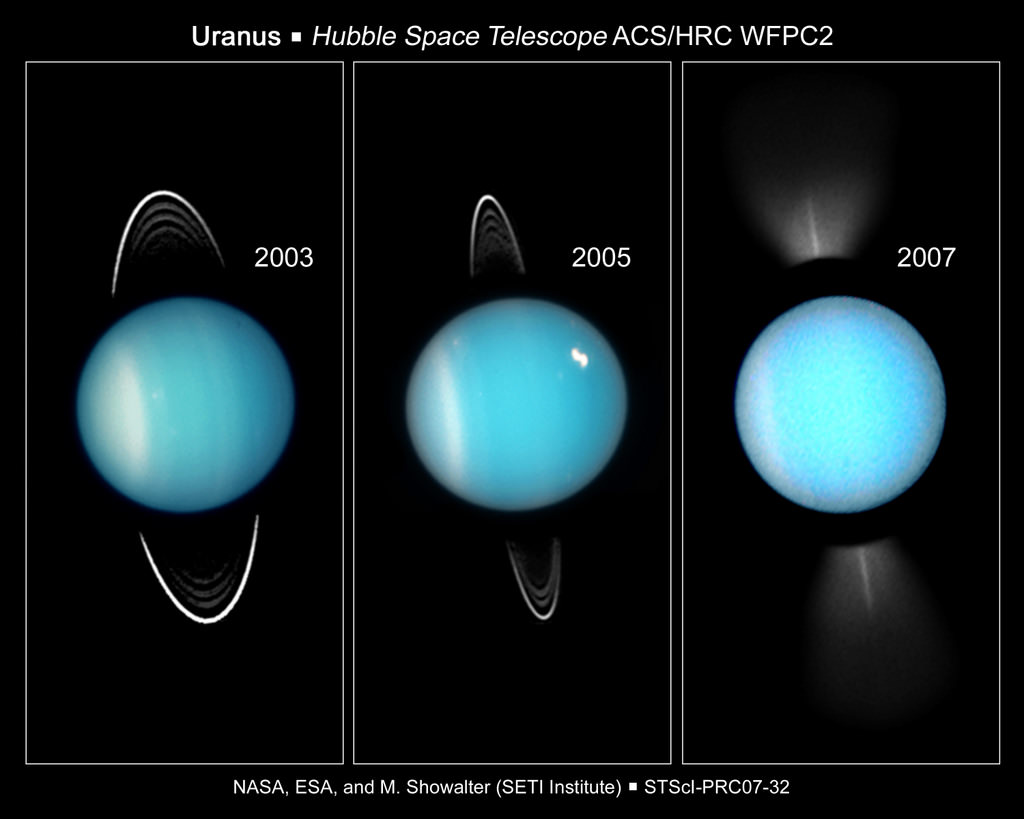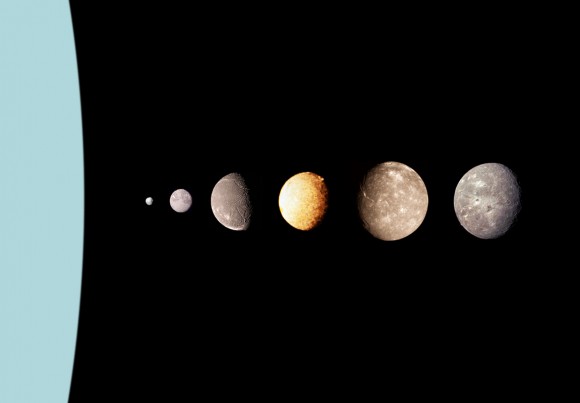In the outer Solar System, there are many worlds that are so large and impressive to behold that they will probably take your breath away. Not only are these gas/ice giants magnificent to look at, they are also staggering in size, have their own system a rings, and many, many moons. Typically, when one speaks of gas (and/or ice) giants and their moons, one tends to think about Jupiter (which has the most, at 67 and counting!).
But have you ever wondered how many moons Uranus has? Like all of the giant planets, it’s got rather a lot! In fact, astronomers can now account for 27 moons that are described as “Uranian”. Just like the other gas and ice giants, these moons are motley bunch that tell us much about the history of the Solar System. And, just like Jupiter and Saturn, the process of discovering these moons has been long and involved on multiple astronomers.
Discovery and Naming:
The process of discovery began in the 18th century with astronomer William Herschel. On January 11th, 1787, he observed the moons of Oberon and Titania, six years after discovering Uranus itself. At the time, Herschel claimed to have observed up to six satellites, as well as a ring (these were later discredited). For fifty years, Herschel’s instrument was the only one with which the moons had been seen.
However, by the 1840s, more advanced instruments and a more favorable position of Uranus led to Oberon and Titania being viewed again, as well as the detection of two additional moons. These moons, Ariel and Umbriel, were detected by William Lassell in 1851. Along with Oberon and Titania, Lassell numbered the moons I through IV from Uranus outward.
In 1852, Herschel’s son John Herschel gave the four moons their current names, using characters from Alexander Pope’s The Rape of the Lock, and William Shakespeare’s A Midsummer Night’s Dream. Ariel and Umbriel were named for Pope’s characters, while Titania and Oberon were named for the queen and king of the fairies in Dream.

In 1948, Gerard Kuiper discovered the smallest and the last of the five large, spherical moons. Consistent with the names applied by John Herschel, the planet was named Miranda after another one of Pope’s characters. Decades later, the flyby of the Voyager 2 space probe in January 1986 led to the discovery of ten further inner moons.
Another satellite, Perdita, was retroactively discovered in 1999 after studying old Voyager photographs. Since 1997, nine distant irregular moons have been identified using ground-based telescopes. Two more small inner moons, Cupid and Mab, were discovered using the Hubble Space Telescope in 2003. As of 2012, the moon Margaret was the last Uranian moon to be discovered.
Uranus’ Large Moons:
The largest moons of Uranus are – in order of size – Miranda, Ariel, Umbriel, Oberon and Titania. They range in diameter and mass from 472 km and 6.7 × 1019 kg for Miranda to 1578 km and 3.5 × 1021 kg for Titania. Each of these moons is particularly dark, with low bond and geometric albedos. Ariel is the brightest while Umbriel is the darkest.
All of the large moons of Uranus are believed to have formed in the accretion disc, which existed around Uranus for some time after its formation, or resulted from the large impact suffered by Uranus early in its history.

Each one is comprised of roughly equal amounts of rock and ice, except for Miranda which is made primarily of ice. The ice component may include ammonia and carbon dioxide, while the rocky material is believed to be composed of carbonaceous material, including organic compounds. Their composition is believed to be differentiated, with an icy mantle surrounding a rocky core.
In the case of Titania and Oberon, it is believed that liquid water oceans may exist at the core/mantle boundary. Their surfaces are also heavily cratered; but in each case, endogenic resurfacing has led to a degree of renewal of their surfaces. Ariel appears to have the youngest surface with the fewest impact craters while Umbriel appears to be the the oldest and most cratered.
The major moons of Uranus have no discernible atmosphere. Also, because of their orbit around Uranus, they experience extreme seasonal cycles. Uranus orbits the Sun almost on its side, and the large moons all orbit around Uranus’ equatorial plane, the northern and southern hemispheres experience prolonged periods of daytime and nighttime (42 years at a time).
Uranus’ Inner Moons:
As of 2008, Uranus is known to possess 13 inner moons who’s orbits lie inside that of Miranda. They are, in order of distance from the planet: Cordelia, Ophelia, Bianca, Cressida, Desdemona, Juliet, Portia, Rosalind, Cupid, Belinda, Perdita, Puck and Mab. Consistent with the naming of the Uranus’ larger moons, all are named after characters from Shakespearean plays.

All inner moons are intimately connected to Uranus’ ring system, which probably resulted from the fragmentation of one or several small inner moons. Puck, at 162 km, is the largest of the inner moons of Uranus – and the only one imaged by Voyager 2 in any detail -while Puck and Mab are the two outermost inner satellites of Uranus.
All inner moons are dark objects. They are made of water ice contaminated with a dark material, which is probably organic materials processed by Uranus’ radiation. The system is also chaotic and apparently unstable. Computer simulations estimate that collisions may occur, particularly between Desdemona and Cressida or Juliet within the next 100 million years.
Uranus’ Irregular Moons:
As of 2005, Uranus is also known to have nine irregular moons, which orbit it at a distance much greater than that of Oberon. All the irregular moons are probably captured objects that were trapped by Uranus soon after its formation. They are, in order of distance from Uranus: Francisco, Caliban, Stephano, Trincutio, Sycorax, Margaret, Prospero, Setebos, and Ferdinard (once again, named for characters in Shakespearean plays).
Uranus’s irregular moons range in size from about 150 km (Sycorax) to 18 km (Trinculo). With the exception of Margaret, all circle Uranus in retrograde orbits (meaning they orbit the planet in the opposite direction of its spin).
Much like the Inner Moons, Uranus’ Irregulars are subject to chaotic instability. It is believed that some may collide with Inner Moons and even be ejected in the next 10 million to one billion years.
Most of what is known about Uranus’ moons is owed to the Voyager 2 space probe, which remains the only spacecraft to have photographed the Uranian satellites up close. Nevertheless, what has been observed has been enough to keep astronomers and planetary scientists interested and guessing. Until the day comes when we can examine the Uranians in greater detail, they will continue to hold their share of secrets.
We have written many articles about Uranus on Universe Today. Here’s Ten Interesting Facts About Uranus, How Many Rings Does Uranus Have?, Uranus Has Bizarre Weather. and Voyager 2 at Uranus, 25 Years Ago Today.
Here’s a link to NASA’s Solar System Exploration Guide on the moons of Uranus, and here’s an article about a Hubble discovery of new rings and moons around Uranus.
We have recorded an episode of Astronomy Cast just about Uranus. You can access it here: Episode 62: Uranus.


The fact that the outer moons orbit retrograde doesn’t mean much to me when the planet is tilted so far over.
What I find far more compelling is that the moons at least out to Oberon are not orbiting far out of the plane of the planet’s spin and instead in the plane of the the general planets.
Consider the theory is that Uranus is a fused object that gyroscopically rotated over after merger – this had to happen early on for the general cloud to still have things to forms moons with. But not anything since then either? Especially if the outer moons aren’t in stable orbits??
And this doesn’t seem to be very very unusual. Pluto-Charon etc are all orbiting at a high angle too. Here the presumption is the whole system is characterized by an impact and the orbiting of Pluto-Charon.
But for Uranus?
And given there are theories that Neptune and Uranus used to orbit reversed and further in that is a lot to hold together in some other orientation, no?
I don’t know – the whole thing is weird and I’ve not heard any good explanation for it.
As far as I know, the moons (Pluto’s as well as Uranus’) are orbiting with only small inclination with respect to their laplace plane. This ist what moons usually do. The laplace plane is defined by the angular momentum of the equatorial bulk of the orbited planet, the sun and – to a minor degree – by other planets (minimizing the torque due to them). That’s why inner moons usually orbit in the equatorial plane of the planet, e.g. the larger moons of Uranus, Jupiter and Saturn (exception: Iapetus). The small moons far away from the central planet usually orbit in the orbital plane of the planet around the sun (also: earth’s moon). There is no connection to prior catastrophic events in the planets history.
Thank you for an informative article. Minor correction:
“The process of discovery began in the 18th century with astronomer William Herschel. On January 11th, 1878, he observed the moons of Oberon and Titania, six years after discovering Uranus itself.”
The year should read 1778, not 1878.
It’s actually 1787, total brain-fart there. Thanks for noticing 🙂